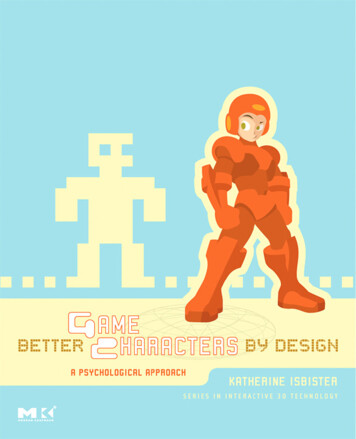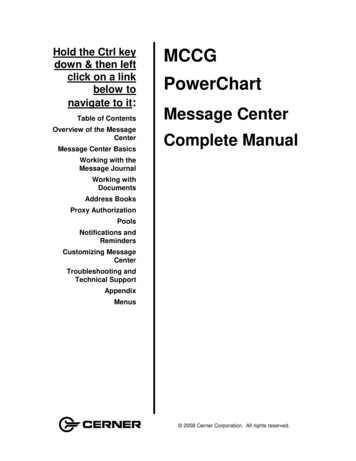
Transcription
O921-Prelims.qxd5/19/0611:15 AMPage iIf the characters in a game have depth, complexity, consistency, mystery, humanity,and charm, then they are going to feel real to the player, and that helps the wholegame world feel real, and allows the player to suspend his or her disbelief and getlost in the world. Everything the player does will be more exciting if they’re doing itfor someone, or with someone, or in opposition to someone who feels real. Simplyput, good character design helps the player to have what we all know can be anamazing, unforgettable experience. This book is not just about making great characters, but also about making great games.—from the foreword by Tim Schafer, Double Fine ProductionsKatherine Isbister skillfully draws upon various psychological constructs elevatinggame development to a more comprehensive level. Taking a Psych 100 class? Thisbook transforms the sometimes stuffy theories of Freud, Skinner, Rogers, andMaslow into fresh and entertaining relevancy as the author weaves these ideas intogame content. The next time you play a favorite video game, read this book—thatgame will take on a whole new light and who knows? You may be able to ace thatpsychology final.—Pauline Pedersen, Course Director, Full Sail Real World EducationThe notion of using psychological principles in games continues to be of great interest to the games industry, but few researchers have been able to discuss in depth howpsychological research can actually be applied to game design. Katherine Isbister’sbook not only makes complex psychological concepts accessible to the games community, but also demonstrates its application in current games through the use of concrete examples (on retail products), and possible design tips and recommendations.—Randy Pagulayan, PhD, User Research Lead, Microsoft Game StudiosKatherine Isbister has crafted a text that covers a far greater scope of psychologicalconcerns than I would’ve previously thought possible, and each area of psychologyshe covers has the potential to bring games to a higher level. For any individualstudying, teaching, or working in Game Design this is a must-have text.—Robin Koman, Associate Course Director, Full Sail Real World EducationA valuable tool for applying effective principles of psychology to create readable, entertaining, and high-impact game characters—a must-have for today’s game developer.—Andrew Stern, co-creator of the interactive drama Façade andthe virtual pets Dogz and CatzWell researched and perceptive, this book offers new insights on creating more emotionally engaging game characters. If you have ever been curious about the psychology behind better character design, this book is a must read!—Nicole Lazzaro, President, XEODesign, Inc.
O921-Prelims.qxd5/19/0611:15 AMPage iThis page intentionally left blank
O921-Prelims.qxd5/19/0611:15 AMPage iiiBetter Game Characters by Design
O921-Prelims.qxd5/19/0611:15 AMPage ivThe Morgan Kaufmann Series in Interactive 3D TechnologySeries Editor: David H. Eberly, Geometric Tools, Inc.The game industry is a powerful and driving force in the evolution of computer technology. As thecapabilities of personal computers, peripheral hardware, and game consoles have grown, so has thedemand for quality information about the algorithms, tools, and descriptions needed to take advantage of this new technology. To satisfy this demand and establish a new level of professional reference for the game developer, we created the Morgan Kaufmann Series in Interactive 3D Technology.Books in the series are written for developers by leading industry professionals and academicresearchers, and cover the state of the art in real-time 3D. The series emphasizes practical, workingsolutions and solid software-engineering principles. The goal is for the developer to be able to implement real systems from the fundamental ideas, whether it be for games or for other applications.Better Game Characters by Design: A Psychological ApproachKatherine IsbisterArtificial Intelligence for GamesIan MillingtonVisualizing QuaternionsAndrew J. Hanson3D Game Engine Architecture: Engineering Real-Time Applications with Wild MagicDavid H. EberlyReal-Time Collision DetectionChrister EricsonPhysically Based Rendering: From Theory to ImplementationMatt Pharr and Greg HumphreysEssential Mathematics for Games and Interactive Applications: A Programmer’s GuideJames M. Van Verth and Lars M. BishopGame PhysicsDavid H. EberlyCollision Detection in Interactive 3D EnvironmentsGino van den Bergen3D Game Engine Design: A Practical Approach to Real-Time Computer GraphicsDavid H. EberlyFORTHCOMINGReal-Time CamerasMark Haigh-HutchinsonX3D: Extensible 3D Graphics for Web AuthorsLeonard Daly and Donald BrutzmanGame Physics Engine DevelopmentIan Millington
O921-Prelims.qxd5/19/0611:15 AMPage vBetter Game Characters by DesignA Psychological ApproachKatherine Isbister, PhDRensselaer Polytechnic InstituteAMSTERDAM BOSTON HEIDELBERG LONDONNEW YORK OXFORD PARIS SAN DIEGOSAN FRANCISCO SINGAPORE SYDNEY TOKYOMorgan Kaufmann Publishers is an imprint of Elsevier
O921-Prelims.qxd5/19/0611:15 AMPage viSenior EditorPublishing Services ManagerProject ManagerAssistant EditorEditorial AssistantCover DesignCover IllustrationText DesignCompositionTechnical IllustrationCopyeditorProofreaderIndexerInterior printerCover printerTim CoxSimon CrumpDawnmarie SimpsonRick CampJessica EvansChen Design AssociatesChen Design AssociatesYvo Riezebos DesignIntegra Software Services Pvt. Ltd.Dartmouth Publishing, Inc. and Thomas BurnsElisabeth BellerJohn BregoliBroccoli Information ManagementThe Maple-Vail Book Manufacturing GroupPhoenixMorgan Kaufmann Publishers is an imprint of Elsevier.500 Sansome Street, Suite 400, San Francisco, CA 94111This book is printed on acid-free paper. 2006 Katherine Isbister. Published by Elsevier Inc. All rights reserved.Designations used by companies to distinguish their products are often claimed as trademarks orregistered trademarks. In all instances in which Morgan Kaufmann Publishers is aware of a claim,the product names appear in initial capital or all capital letters. Readers, however, should contact theappropriate companies for more complete information regarding trademarks and registration.No part of this publication may be reproduced, stored in a retrieval system, or transmitted in any formor by any means—electronic, mechanical, photocopying, scanning, or otherwise—without priorwritten permission of the publisher.Permissions may be sought directly from Elsevier’s Science & Technology Rights Department inOxford, UK: phone: ( 44) 1865 843830, fax: ( 44) 1865 853333, e-mail: permissions@elsevier.co.uk.You may also complete your request on-line via the Elsevier homepage (http:/ /elsevier.com) byselecting “Customer Support” and then “Obtaining Permissions.”Library of Congress Cataloging-in-Publication DataIsbister, Katherine, 1969–Better game characters by design: a psychological approach/by Katherine Isbister.p. cm.Includes bibliographical references and Index.ISBN-13: 978-1-55860-921-1 (pbk. : alk. paper)ISBN-10: 1-55860-921-0 (pbk. : alk. paper)1. Computer games—Design—Psychological aspects. 2. Computer games—Design—Social aspects.I. Title.QA76.76.C672I72 2005794.8 1536 0019—dc222005024294ISBN 13: 978-1-55860-921-1ISBN 10: 1-55860-921-0DVD ISBN 13: 978-0-12-369535-2DVD ISBN 10: 0-12-369535-XFor information on all Morgan Kaufmann publications,visit our Web site at www.mkp.com or www.books.elsevier.comPrinted in the United States of America06 07 08 09 105 4 3 2 1Working together to growlibraries in developing countrieswww.elsevier.com www.bookaid.org www.sabre.org
O921-Prelims.qxd5/19/0611:15 AMPage viiThis book is dedicated to my students, who remind me everyday of the delight andthrill of creative work. And to my Dad, who passed along his curiosity and love oflearning to me.vii
O921-Prelims.qxd5/19/0611:15 AMPage iThis page intentionally left blank
O921-Prelims.qxd5/19/0611:15 AMPage ixABOUT THE AUTHORKatherine Isbister is an associate of the Social and Behavioral Research Laboratoryand an associate professor in the Department of Language, Literature and Communication at the Rensselaer Polytechnic Institute. Her research focus is social psychological and affective approaches to HCI (Human-Computer Interaction), with specialattention to games and other leisure and social technologies. In autumn 2004, sheestablished the Games Research Lab at Rensselaer. Initial studies in the lab haveexplored the social and physical aspects of party games. She has presented insightsfrom this research at the Game Developers Conference and at the DiGRA (DigitalGames Research Association) conference.Before joining the RPI faculty, Katherine developed and taught a course in Stanford University’s HCI series—Designing Characters for Computer Games—now partof Rensselaer’s games curriculum. She has also created and exhibited games-relatedartwork in venues including San Francisco’s Yerba Buena Center for the Arts,Toronto’s Design Exchange, and San Jose’s Works Gallery. See www.simgallery.netfor an overview of this artwork which is a collaboration with sculptor RaineyStraus.Katherine is also part of the European Network of Excellence project HUMAINE,devoted to evolving appropriate usability and evaluation strategies for assessingaffective interfaces. As part of this work, she has an ongoing research collaborationwith the Royal Institute of Technology in Stockholm, Sweden. In 1999, she wasselected as one of MIT Technology Review’s “100 Young Innovators” most likely toshape the future of technology.ix
O921-Prelims.qxd5/19/0611:15 AMPage iThis page intentionally left blank
O921-Prelims.qxd5/19/0611:15 AMPage xiTABLE OF CONTENTSAbout the Author . . . . . . . . . . . . . . . . . . . . . . . . . . . . . . . . . . . . . . . . . . . . . . . . . . . . . . . . . . . . . . . . . . . . . . . . . . . . . . . . . . . . . . . . . . . . . . . . . . . . . . . . . . . . . . . . . . . . ixForeword . . . . . . . . . . . . . . . . . . . . . . . . . . . . . . . . . . . . . . . . . . . . . . . . . . . . . . . . . . . . . . . . . . . . . . . . . . . . . . . . . . . . . . . . . . . . . . . . . . . . . . . . . . . . . . . . . . . . . . . . . . . . . . . . xviiPreface . . . . . . . . . . . . . . . . . . . . . . . . . . . . . . . . . . . . . . . . . . . . . . . . . . . . . . . . . . . . . . . . . . . . . . . . . . . . . . . . . . . . . . . . . . . . . . . . . . . . . . . . . . . . . . . . . . . . . . . . . . . . . . . . . . . . . . xixAbout the DVD-ROM . . . . . . . . . . . . . . . . . . . . . . . . . . . . . . . . . . . . . . . . . . . . . . . . . . . . . . . . . . . . . . . . . . . . . . . . . . . . . . . . . . . . . . . . . . . . . . . . . . . . . . . . . . xxvIFirst ImpressionsWhat Is Covered and Why . . . . . . . . . . . . . . . . . . . . . . . . . . . . . . . . . . . . . . . . . . . . . . . . . . . . . . . . . . . . . . . . . . . . . . . . . . . . . . . . . . . . . . . . . . . . . . . . . . . . . 1Who Will Find Part I Most Useful . . . . . . . . . . . . . . . . . . . . . . . . . . . . . . . . . . . . . . . . . . . . . . . . . . . . . . . . . . . . . . . . . . . . . . . . . . . . . . . . . . . . . . . . . 1Overview of Key Concepts . . . . . . . . . . . . . . . . . . . . . . . . . . . . . . . . . . . . . . . . . . . . . . . . . . . . . . . . . . . . . . . . . . . . . . . . . . . . . . . . . . . . . . . . . . . . . . . . . . . . 1Take-Aways from Part I . . . . . . . . . . . . . . . . . . . . . . . . . . . . . . . . . . . . . . . . . . . . . . . . . . . . . . . . . . . . . . . . . . . . . . . . . . . . . . . . . . . . . . . . . . . . . . . . . . . . . . . . . . . 41Social Surface1.1What Is Covered and Why . . . . . . . . . . . . . . . . . . . . . . . . . . . . . . . . . . . . . . . . . . . . . . . . . . . . . . . . . . . . . . . . . . . . . . . . . . . . . . . . . . . . . . . . . . . . . . . . . . . . . 51.2The Psychological Principles . . . . . . . . . . . . . . . . . . . . . . . . . . . . . . . . . . . . . . . . . . . . . . . . . . . . . . . . . . . . . . . . . . . . . . . . . . . . . . . . . . . . . . . . . . . . . . . . 51.3Design Pointers . . . . . . . . . . . . . . . . . . . . . . . . . . . . . . . . . . . . . . . . . . . . . . . . . . . . . . . . . . . . . . . . . . . . . . . . . . . . . . . . . . . . . . . . . . . . . . . . . . . . . . . . . . . . . . . . . . . . . . 161.4Interview: Gonzalo Frasca . . . . . . . . . . . . . . . . . . . . . . . . . . . . . . . . . . . . . . . . . . . . . . . . . . . . . . . . . . . . . . . . . . . . . . . . . . . . . . . . . . . . . . . . . . . . . . . . . . . 171.5Summary and What Is Next . . . . . . . . . . . . . . . . . . . . . . . . . . . . . . . . . . . . . . . . . . . . . . . . . . . . . . . . . . . . . . . . . . . . . . . . . . . . . . . . . . . . . . . . . . . . . . . . 211.6Exercises . . . . . . . . . . . . . . . . . . . . . . . . . . . . . . . . . . . . . . . . . . . . . . . . . . . . . . . . . . . . . . . . . . . . . . . . . . . . . . . . . . . . . . . . . . . . . . . . . . . . . . . . . . . . . . . . . . . . . . . . . . . . . . . . . . . . 211.7Further Reading . . . . . . . . . . . . . . . . . . . . . . . . . . . . . . . . . . . . . . . . . . . . . . . . . . . . . . . . . . . . . . . . . . . . . . . . . . . . . . . . . . . . . . . . . . . . . . . . . . . . . . . . . . . . . . . . . . . . . 212Practical Questions—Dominance,Friendliness, and Personality2.1What Is Covered and Why . . . . . . . . . . . . . . . . . . . . . . . . . . . . . . . . . . . . . . . . . . . . . . . . . . . . . . . . . . . . . . . . . . . . . . . . . . . . . . . . . . . . . . . . . . . . . . . . . . . 232.2The Psychological Principles . . . . . . . . . . . . . . . . . . . . . . . . . . . . . . . . . . . . . . . . . . . . . . . . . . . . . . . . . . . . . . . . . . . . . . . . . . . . . . . . . . . . . . . . . . . . . . 24xi
O921-Prelims.qxd5
09.11.2011 · ogy behind better character design, this book is a must read! —Nicole Lazzaro, President, XEODesign, Inc. O921-Prelims.qxd 5/19/06 11:15 AM Page i . O921-Prelims.qxd 5/19/06 11:15 AM Page i This page intentionally left blank. Better Game Characters by Design O921-Prelims.qxd 5/19/06 11:15 AM Page iii. The Morgan Kaufmann Series in Interactive 3D Technology Series Editor: David H.Eberly .











